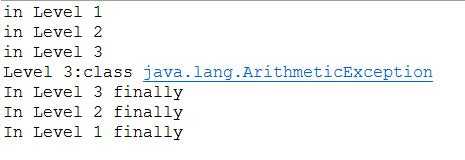标签:检测 ima for cep 结束 用户输入 相同 执行 java
一.动手动脑:请阅读并运行AboutException.Java示例,然后通过后面的几页ppt了解Java中实现异常处理的基础知识。
(1)源代码:
import javax.swing.*; class AboutException { public static void main(String[] a) { double i=1, j=0, k; k=i/j; try { k = i/j; // Causes division-by-zero exception //throw new Exception("Hello.Exception!"); } catch ( ArithmeticException e) { System.out.println("被0除. "+ e.getMessage()); } catch (Exception e) { if (e instanceof ArithmeticException) System.out.println("被0除"); else { System.out.println(e.getMessage()); } } finally { JOptionPane.showConfirmDialog(null,"OK"+k);//正无穷 } } }
(2)结果分析:
Java中的异常捕获语句
Try{
//可能发生运行错误的代码;
}
catch(异常类型 异常对象引用){
//用于处理异常的代码
}
finally{
//用于“善后” 的代码
}
Java中所有可捕获的异常都派生自Exception类。
二.使用Java异常处理机制
?把可能会发生错误的代码放进try语句块中。
?当程序检测到出现了一个错误时会抛出一个异常对象。异常处理代码会捕获并处理这个错误。catch语句块中的代码用于处理错误。
?当异常发生时,程序控制流程由try语句块跳转到catch语句块。
?不管是否有异常发生,finally语句块中的语句始终保证被执行。
?如果没有提供合适的异常处理代码,JVM将会结束掉整个应用程序。
异常的“多态”特性
可以有多个catch语句块,每个代码块插获一种异常。在某个try块后有两个不同的catch块插获两个相同类型的异常是语法错误。
使用catch语句,只能捕获Exception类及其子类的对象。因此,一个捕获Exception对象的catch语句块可以捕获所有“可捕获”的异常。
将catch(Exception e)放在别的catch块前面会使这些catch块都不执行,因此Java不会编译这个程序。
三.动手动脑:多层的异常捕获-1
阅读以下代码(CatchWho.Java),写出程序运行结果:
(1)源代码:
public class CatchWho { public static void main(String[] args) { try { try { throw new ArrayIndexOutOfBoundsException(); } catch(ArrayIndexOutOfBoundsException e) { System.out.println( "ArrayIndexOutOfBoundsException" + "/内层try-catch"); } throw new ArithmeticException(); } catch(ArithmeticException e) { System.out.println("发生ArithmeticException"); } catch(ArrayIndexOutOfBoundsException e) { System.out.println( "ArrayIndexOutOfBoundsException" + "/外层try-catch"); } } }
(2)

(3)抛出两次异常,先处理内层的,再处理外层的。
四.动手动脑:多层的异常捕获-2
阅读以下代码(CatchWho2.Java),写出程序运行结果:
(1)源代码:
public class CatchWho2 { public static void main(String[] args) { try { try { throw new ArrayIndexOutOfBoundsException(); } catch(ArithmeticException e) { System.out.println( "ArrayIndexOutOfBoundsException" + "/内层try-catch"); } throw new ArithmeticException(); } catch(ArithmeticException e) { System.out.println("发生ArithmeticException"); } catch(ArrayIndexOutOfBoundsException e) { System.out.println( "ArrayIndexOutOfBoundsException" + "/外层try-catch"); }//当不能比对成功,接着向下运行,比对成功,直接输出 } }
(2)

(3)
当不能比对成功,接着向下运行,比对成功,直接输出 。
五.动手动脑 当有多个嵌套的try…catch…finally时,要特别注意finally的执行时机。
(1)源代码:
public class EmbededFinally { public static void main(String args[]) { int result; try { System.out.println("in Level 1"); try { System.out.println("in Level 2"); // result=100/0; //Level 2 try { System.out.println("in Level 3"); result=100/0; //Level 3 } catch (Exception e) { System.out.println("Level 3:" + e.getClass().toString()); } finally { System.out.println("In Level 3 finally"); } // result=100/0; //Level 2 } catch (Exception e) { System.out.println("Level 2:" + e.getClass().toString()); } finally { System.out.println("In Level 2 finally"); } // result = 100 / 0; //level 1 } catch (Exception e) { System.out.println("Level 1:" + e.getClass().toString()); } finally { System.out.println("In Level 1 finally"); } } }
(2)

(3)当有多层嵌套的finally时,异常在不同的层次抛出 ,在不同的位置抛出,可能会导致不同的finally语句块执行顺序。
六. finally语句块一定会执行吗?(SystemExitAndFinally.Java)
(1)
public class SystemExitAndFinally { public static void main(String[] args) { try{ System.out.println("in main"); throw new Exception("Exception is thrown in main"); //System.exit(0); } catch(Exception e) { System.out.println(e.getMessage()); System.exit(0); } finally { System.out.println("in finally"); } } }
(2)

(3)不一定执行。如在例子中,System.exit(0);导致finally并没有执行。
七.动手动脑:
编写一个程序,此程序在运行时要求用户输入一个 整数,代表某门课的考试成绩,程序接着给出“不及格”、“及格”、“中”、“良”、“优”的结论。
要求程序必须具备足够的健壮性,不管用户输入什 么样的内容,都不会崩溃。
(1)
import java.util.*; class GeshiException extends Exception { public GeshiException(String a) { super(a); } } public class Grade { public static void judge(int g){ if(g>=0&&g<60) System.out.println("成绩不合格!"); else if(g<70) System.out.println("成绩合格!"); else if(g<80) System.out.println("成绩中!"); else if(g<90) System.out.println("成绩良!"); else if(g<=100) System.out.println("成绩优!"); else System.out.println("但输入成绩不符"); } public static void main(String[] args) { Scanner b=new Scanner(System.in); String b1; int c=1; System.out.println("请输入学生的成绩:"); while(c==1) { boolean d=true; try { b1=b.nextLine(); for(int i=0;i<b1.length();i++) { if(b1.charAt(i)>57||b1.charAt(i)<46) { d=false; } } if(!d) { GeshiException a=new GeshiException("输入有误!不是的不是数字!"); throw a; } else { c=2; int g1=Integer.parseInt(b1); System.out.print("输入正确!"); judge(g1); } } catch(GeshiException a) { System.out.print(a+"请重新输入:"); } } b.close(); } }
(2)

标签:检测 ima for cep 结束 用户输入 相同 执行 java
原文地址:http://www.cnblogs.com/zhangjiabei/p/6096218.html